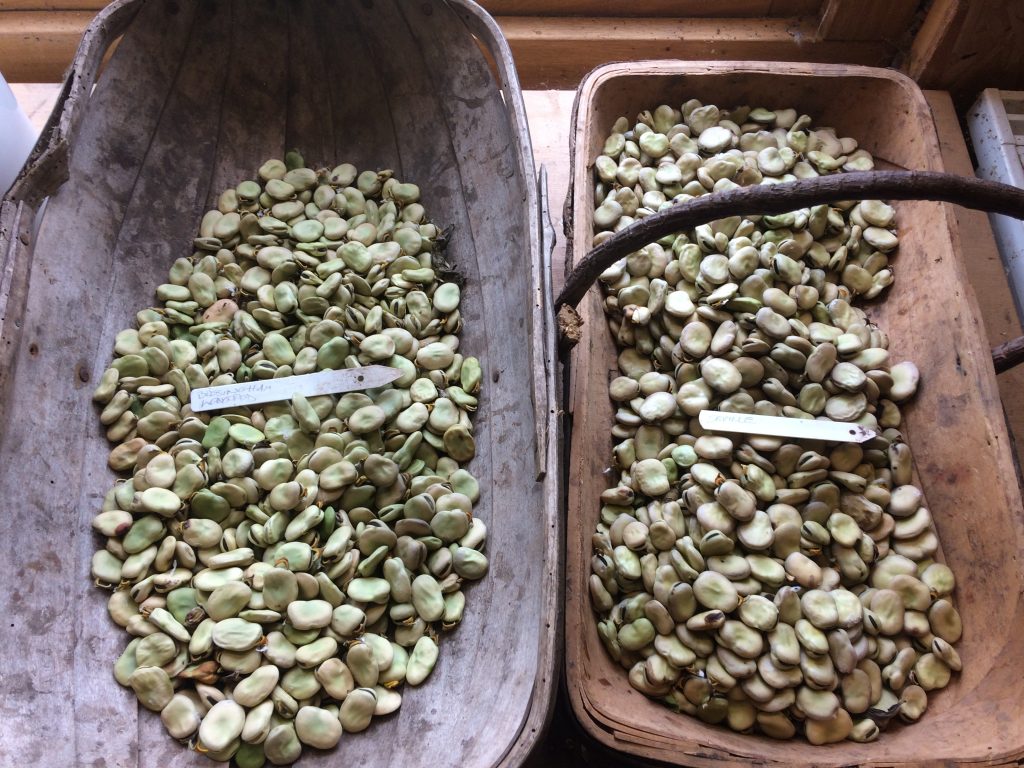
The latest list of seeds I have to share can be found here http://www.veggingoutwithadam.com/seed-library/seed-list-2021/
Enjoy!
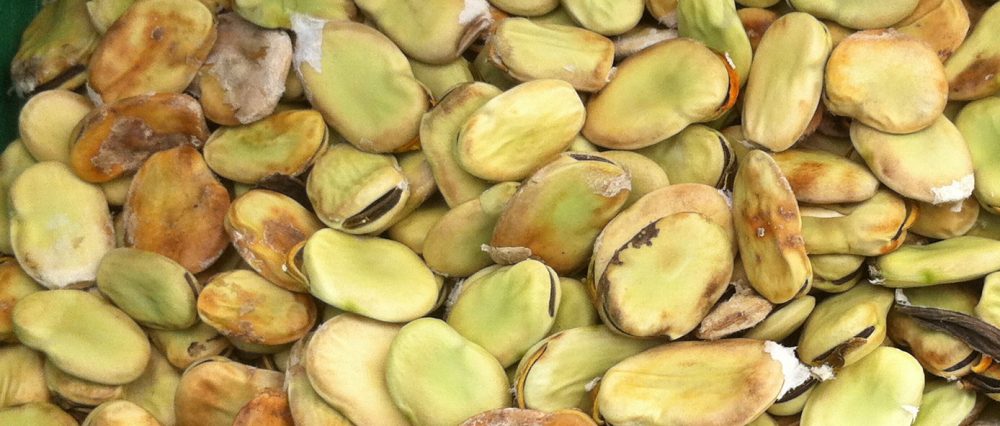

The latest list of seeds I have to share can be found here http://www.veggingoutwithadam.com/seed-library/seed-list-2021/
Enjoy!
All my tips, ideas and posts aimed at helping people who would like to grow a few veggies but have no experience or knowledge can now be found on my website in the ‘How to Grow Stuff’ link on the menu bar above. Each episode focuses on one type of vegetable and I will add to them as seeds germinate, plants grow and hopefully I get to harvest a crop.
Many old favourites and a few new varieties I have added to my library. If you want to try some rare, endangered, delicious and colourful heritage, heirloom and ex-commercial veggies in 202 do check out my 2020 seed list. Many are varieties i have grown out for the Heritage Seed Library. If you want to enjoy growing more from their library then, if you are not a member, I would urge you to join.
It has been a trying but very busy summer and it is with considerable guilt that I see it has been three months since I last blogged. Quelle domage. A number of people have been giving me a hard time, so now I shall do my best to make amends.
Firstly, despite all the shite weather I have had more success than failures. Last year I suffered terribly from white rot on my onions and garlic. So awful was it that I thought I should abandon trying to grow these vegetables on my allotment for several years. I then did some research and discovered that growing brassicas as a green manure on infected ground could help to limit the disease, which is caused by a pesky nematode. To that end I sowed Calente mustard seed on one of the raised beds I had earmarked for onions last autumn. In the spring I ran the mower over the crop to shred it and then turned it into the soil. I allowed it to break down over a few weeks bedore planting up onions. And this year I have no white rot. This is a method I will now continue to employ for next year’s spring crop. I have just sown some more mustard seed in a bed I would like to plant garlic into in November. Hoepfully the next couple of months should be long enough to get the mustard to grow sufficient to kill aberant nematodes.
since the British weather has been going loopy I have decided to grow more crops in my polytunnels for everyday use. My over-wintered peas and beans were fantastic this year, so I have now planted a bed of the red onion variety Electric for an early summer crop next year. I have also planted up some of the garlic I rreceived from Oman with a comparator crop planted on the allotment. I have also got the fabulous kale Ragged Jack as well as January King cabbages gowing under polythene as well as a late sowing of beetroot, carrots and some tasty winter crops of mizuna, red mustard, lettuce – with more to follow soon – spinach, chard and the fabulous winter radish Pasque. With summer over and the nights about to become longer than the days I hope we stay dry to allow my squash and sweet potatoes to ripen in the polytunnels.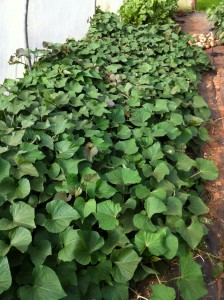
Back in May I bough for a tenner a half-hundred weight sack of Charlotte spuds which I put in an empty fridge at a temperature of 5 degrees centigrade. Although some of the tubers sprouted mutant-looking chits I have planted a large number which are now taking over one half of a polytunnel! When I see spuds for Christmas being sold for as much as fifty pence each I am glad I have tried this way to save money. Also, with spuds likely to cost an arm and a leg this winter it is good to know I will be digging the beauties from December through to the end of February. If you have can lay your hands on a few Charlotte or Duke of York it is not too late to plant now; ideally into a greenhouse border, or tubs or bags in a greenhouse or very sheltered spot.
Today I couldn’t wait any longer. I had to start sowing. Too early for outside but with one of my polytunnels now empty after completing harvesting new potatoes I had prepared a lovely series of seed beds a week ago, giving a light dressing of fish, blood and bone. In the warmth of a the polytunnel – it being another glorious, sunny day today – I sowed two varieties of carrot; an F1 early from Dobies called Parano and Amsterdam Forcing 3 Sprint from D.T. Brown. I also sowed two varieities of beetroot; Red Ace and Boltardy, both from the Organic Gardening Catalogue. Lettuce varieites were Winter Density from Mr Fothergill and Winter Lattughino, bio-dynamic seed I was given by the head gardener at my oldRudolph Steiner school, Michael Hall. I also broadcast a handfull of winter mixed salad leaf from Dobies and sowed too a short row of rocket from Franchi seeds and Scarlet Globe Radish from Garden organic. To be sure of lots of tsaty leaves in March and April I also sowed a short row of a spinach variety called Campania from Marshalls.
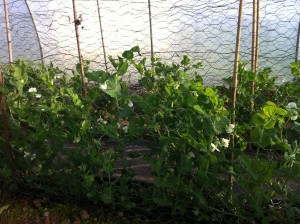 It’s been a very strange winter so far. On 7th October last year I sowed the pea variety Douce Provence in one of my polytunnels. Normally I would expect this variety to grow through the winter to no more than six inches. However, I have a crop now at least a foot hight, if not taller and coming into flower. In fact the first flowers appeared before Christmas. I will be fascinated to see if the crop will set properly if temperatures remain low – already the first flowers have set – and maybe I’ll be eating peas before Easter.
It’s been a very strange winter so far. On 7th October last year I sowed the pea variety Douce Provence in one of my polytunnels. Normally I would expect this variety to grow through the winter to no more than six inches. However, I have a crop now at least a foot hight, if not taller and coming into flower. In fact the first flowers appeared before Christmas. I will be fascinated to see if the crop will set properly if temperatures remain low – already the first flowers have set – and maybe I’ll be eating peas before Easter.
Although I do keep a minimum temperature in my greenhouse I have not expected to still have chillies ripening. However, Pubescens Rocoto, a black-seeded variety is still gowing strong. Very hot and pungent, I expect to keep harvesting through to the end of February!
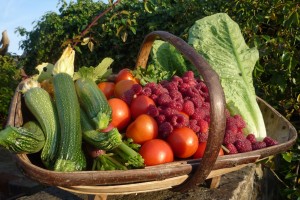 The last couple of months have been busy tending, harvesting and sowing for winter. It is now that one realises the long row of runner beans sown with enthusiasm in May is yielding enough to feed the 5,000. Remember the glut now and which will continue until the frosts kill the plants. A little of lots of different vegetables is more satisfying than a lot of just a few varieties. At this time of year I start to collect and clean seed for myself, for other seed collectors and for the Heritage Seed library.
The last couple of months have been busy tending, harvesting and sowing for winter. It is now that one realises the long row of runner beans sown with enthusiasm in May is yielding enough to feed the 5,000. Remember the glut now and which will continue until the frosts kill the plants. A little of lots of different vegetables is more satisfying than a lot of just a few varieties. At this time of year I start to collect and clean seed for myself, for other seed collectors and for the Heritage Seed library. 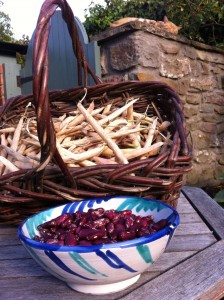 Please check out the website seed saving section to see what I do and how you too can save your own seed to grow next year.
Please check out the website seed saving section to see what I do and how you too can save your own seed to grow next year.
It may be the middle of August but it is not too late to be sowing now for crops later this autumn and into the winter. If you haven’t sown spring cabbage or Kale get started now. I like spring cabbage like Advantage, but the best stuff for those mid-winter meals and good spring greens is kale. My absolute favourite is Asparagus Kale and I have a good supply of fresh seed just harvested. So long as you are able to transplant your brassicas by then end of September you will get a good crop come springtime. Start off seed in pots or root trainers in regular John Innes seed compost. Keep well watered and also protect seedlings from attack by cabbage white butterflies using a screen of enviromesh or fleece which is obtainable from any half-decent garden center.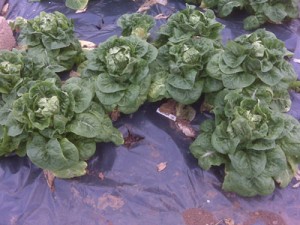
Overwintering lettuce can also be sown now. Winter Density is a very reliable cos-type which if sown outside now can be thinned or transplanted in September either under a sturdy cloche or into the greenhouse border. Large pots in a greenhouse are also good for growing on your lettuce. Allow four plants to a 12-inch pot of good multi-purpose compost. I like to add some dried blood when transplanting to encourage leafy growth. This is especially important early in the new year if you want crisp tasty lettuce for Valentine’s day and before! Other very reliable winter lettuce worth a go are Valdor and the best cos of the lot, Lobjoits Green Cos.
Rocket, Mizuna and many Chinese greens can be sown now for harvesting up until Christmas and beyond if the weather is clement.
The spring may have been hot and dry, but June has changed all that. Cool and wet. The chilly nights haven’t slowed down the rate of growth however and the much-needed rain has come just at the right time for peas and beans which need polnety of water if they are to provide good crops.
After a very slow start and considerable problems from sparrows eating the growing tips, my peas are finally getting into their stride. Early crops sown in March are in full flower and I did eat the first peas yesterday – straight from the pod. My trial of Kew Blue are finally climbing but I fear they may not reach their full potential even though the plants of eight seeds I sowed are flowering quite freely.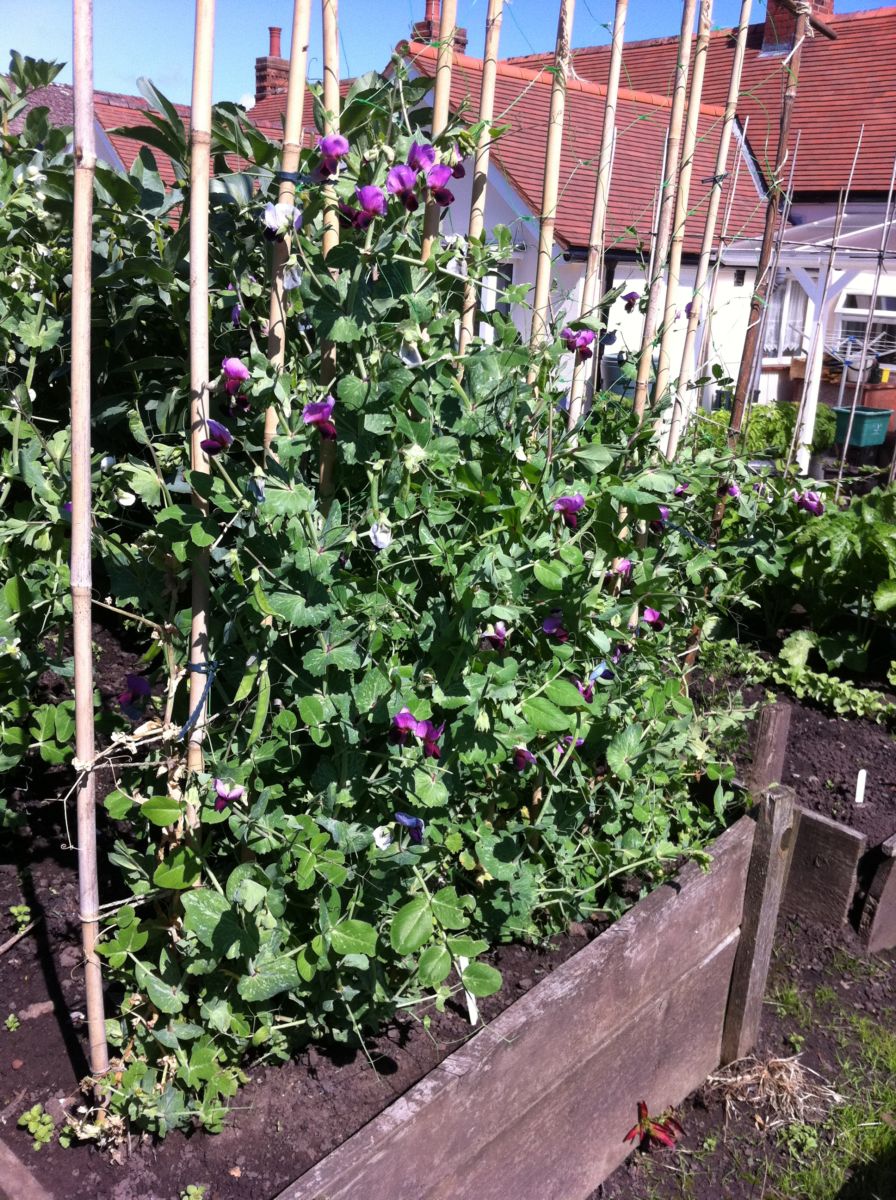
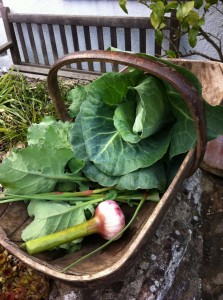
Tundra cabbage, the flowering tops of Delaway winter kale, the first young garlic and a few garlic scrapes will make a wonderful stir-fry
It’s the middle of May and the last couple of weeks have been very busy, catching up with planting, transplanting and sowing. The brassicas I sowed in late March needed to be transplanted into their riased beds. I noticed that the dreaded Small Cabbage wWhite is around and found a few clusters of their yellow eggs on the underside of some of the leaves, so I decided to cover immediately with a fine mesh to protect the crop.
The cabbage and broccoli I transplanted back in March are growing on well and should be ready for eating in the next few weeks.
This very dry spring has been a challenge. Not only do salad crops need lots of water, so do peas and carrots Yesterday I installed a trcikle irrigation system on a couple of my raised beds and over several hours emptied a large water butt onto them. You can see the system at work in this photo. Highly recommended I say. I bought enough tubing and connectors to irrigate 6 of my beds at any one time for just £29. It’s worth checking out www.watermate.co.uk
I am a passionate advocate of polytunnels. They extend the growing season dramatically. Having had problems with overwintering broad beans suffering recent very cold winters I sowed Aquadulce in a polytunnel last November and am now able to harvest a good crop of lovely beans. With my second lot of early potatoes, the delicious variety Accord, now eating well another feast tonight is in order
As well as transplanting cabbages last week I have also transplanted one of the tastiest squash I know, Pompeon, into one of my polytunnels. I am growing aa American heirloom Armenian cucumber too. I planted four rather straggly plants, two-feet apart in the greenhouse on the allotment and plan to train them up canes and along wires. I also planted a couple of melon called Sugar Baby with which I have had some success in the past.
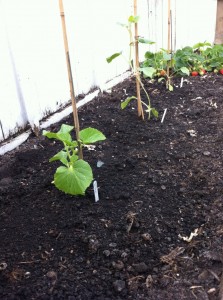
Young Armenian cucumbers with ripening strawberries on 15th MaySyrian courgettes transplanted on 8th May under bell cloches
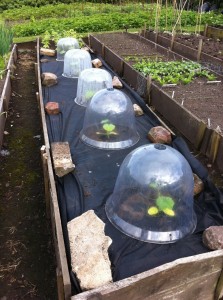
At last, the euinox is just past and for the next six months the sun is in the sky for more than twelve hours a day. Yipee. Lovely early mornings beckon for time alone to sow, plant, hoe and harvest. And boy is it kicking off big-time right now.
Today was just blissful. Clear blue skies, a temperature of 18 degrees and plenty of time to work on the plot.
First up was to transplant a summer cabbage called Greyhound into a bed I had ready at the top of the garden. I had sown seed in root trainers in the greenhouse back in February. The plants have been hardening off in a cold frame for the last three weeks and were ready to go in the gound. Likewise I planted a broccoli called Olympia. A fiendeshly expensive hybrid we’ll see what it does but I got every seed in the packet to grow – 24 in total – so my neighbours are benefiting too. I also planted up a couple of short rows of Little Gem lettuce for good luck.
It was time too to get the last of my early spuds in the ground. Using my tried and tested method of planting through black-poly and covering with a cloche I now have twenty Nadine safely in the soil, and hopefully providing meals in June when the spuds in the polytunnel have all been eaten.
The crops in the polytunnels are doing well now we are having a decent warm spell of weather. I have been harvesting lettuce for some weeks but there are more than enough left to keep me and the neighbours in salad stuff until the frst of the outdoor crops come fit to eat later in April.
My overwintering Aquadulce broad beans are looking promising, the first flower buds are starting to form and I even noticed a solitary bumble bee buzzing hopefully in the tunnel – maybe she needs to wait another couple week for the first flowers to open!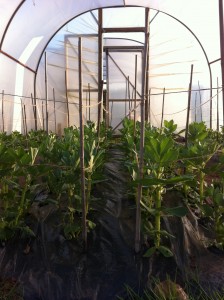
It’s the end of the first week of March. The sun is shining and in my polytunnels and greenhouses the temperature is in the 80’s. But as darkness falls so does the thermometer! This time of year can be a dagerous period. Seduced by longer days and the need to get sowing we hope for the best and scatter our seed injudiciously. Caution is required.
Protected crops can forge ahead. Early potatoes in the polytunnel are already pocking their noses through the soil; broad beans are pushing skyward and lettuce are beginning to fill out. But unless your precious germinating seeds are protected by cloches they may refuse to grow and simply rot. If in doubt, wait a week or two. Later sowings will catch up. Better to prepare seed beds and finish getting the ground in perfect condition to get working later in the month.
Having said all that, I do risk the weather. Just a couple of days ago I transplanted into open ground some early summer cabbage that I had growing over the winter in pots in the greenhouse and more recently, hardening off in a cold frame. My garden greenhouse is absolutely chock-a-block with seedlings. I have started celeriac and fennel, more tomatoes for growing outside – the awesome Salt Spring Sunrise and an orphan from the HSL called Victory. Also early sweet-corn which I will plant in a polytunnel next month for a crop in July – the first of a succession of sowings of sweetcorn over the next two months. Also germinating on the greenhouse bench are various French beans and more cabbage, broccoli and calabrese need to be moved into a cold frame to harden off.
I need to make space because tomorrow I will transplant my peppers and chillies and start some squash going in the propagator. I am on my travels for a couple of weeks so needs must. Hopefully, when I return the greenhouse will be a mini-jungle, my early spuds will be green mounds of loveliness, my lettuce will be begging to be eaten – I did have one tonight for supper, (yum yum) – and my broad benas will have started to flower!
Us gardeners can but dream!